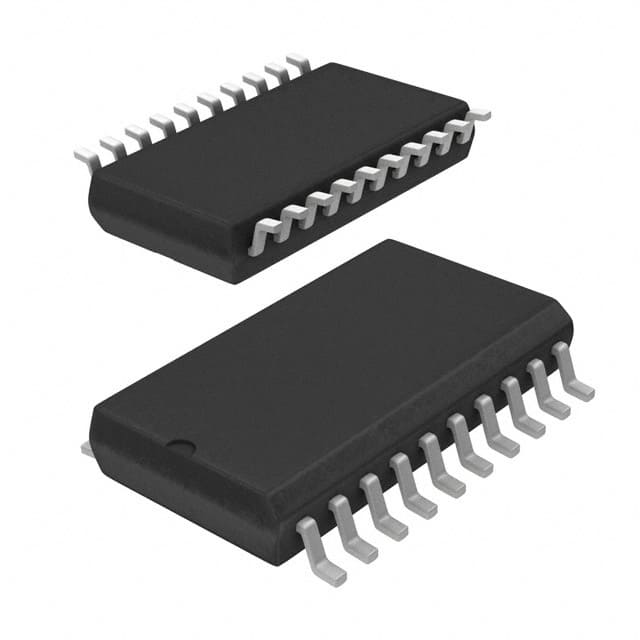Encyclopedia Entry: 74VHC245MTR
Product Overview
Category
The 74VHC245MTR belongs to the category of integrated circuits (ICs), specifically a type of digital logic level shifter.
Use
This IC is commonly used for voltage level shifting in digital systems. It allows for bidirectional data transfer between devices operating at different voltage levels.
Characteristics
- Voltage Compatibility: The 74VHC245MTR is designed to operate with a wide range of input and output voltage levels, making it versatile for various applications.
- High-Speed Operation: This IC offers fast switching speeds, enabling efficient data transfer between devices.
- Bidirectional Capability: It supports bidirectional data flow, allowing for seamless communication between devices.
- Low Power Consumption: The 74VHC245MTR is designed to minimize power consumption, making it suitable for battery-powered devices.
- ESD Protection: It incorporates electrostatic discharge (ESD) protection features, safeguarding against potential damage from static electricity.
Package and Quantity
The 74VHC245MTR is available in a small outline transistor (SOT) package. Each package contains one IC.
Specifications
- Supply Voltage Range: 2.0V to 5.5V
- Input Voltage Range: 0V to VCC
- Output Voltage Range: 0V to VCC
- Maximum Operating Frequency: 200 MHz
- Number of Channels: 8
- Input/Output Logic Levels: CMOS/TTL compatible
Pin Configuration
The 74VHC245MTR has a total of 20 pins, which are assigned as follows:
- OE (Output Enable) - Output Enable Control
- A1 - Data Input/Output Channel 1
- B1 - Data Input/Output Channel 1
- A2 - Data Input/Output Channel 2
- B2 - Data Input/Output Channel 2
- A3 - Data Input/Output Channel 3
- B3 - Data Input/Output Channel 3
- A4 - Data Input/Output Channel 4
- B4 - Data Input/Output Channel 4
- GND (Ground) - Ground Connection
- B5 - Data Input/Output Channel 5
- A5 - Data Input/Output Channel 5
- B6 - Data Input/Output Channel 6
- A6 - Data Input/Output Channel 6
- B7 - Data Input/Output Channel 7
- A7 - Data Input/Output Channel 7
- B8 - Data Input/Output Channel 8
- A8 - Data Input/Output Channel 8
- VCC - Power Supply Voltage
- DIR (Direction) - Direction Control
Functional Features
- Bidirectional Data Transfer: The 74VHC245MTR allows for bidirectional data transfer between devices operating at different voltage levels.
- Output Enable Control: The OE pin enables or disables the outputs, providing flexibility in controlling data flow.
- Direction Control: The DIR pin determines the direction of data transfer, allowing for versatile communication configurations.
Advantages and Disadvantages
Advantages
- Versatile Voltage Compatibility: Supports a wide range of input and output voltage levels, enhancing compatibility with various devices.
- High-Speed Operation: Offers fast switching speeds, facilitating efficient data transfer.
- Bidirectional Capability: Enables seamless communication between devices by supporting bidirectional data flow.
- Low Power Consumption: Designed to minimize power consumption, making it suitable for energy-efficient applications.
- ESD Protection: Incorporates protection against electrostatic discharge, safeguarding against potential damage.
Disadvantages
- Limited Channel Count: The 74VHC245MTR provides a total of 8 channels, which may be insufficient for applications requiring a higher number of data lines.
- SOT Package: The small outline transistor package may pose challenges in terms of heat dissipation and physical handling.
Working Principles
The 74VHC245MTR operates based on the principles of voltage level shifting. It utilizes a combination of transistors and logic gates to convert digital signals between different voltage levels. By controlling the direction of data flow and enabling/disabling outputs, it ensures seamless bidirectional communication between devices operating at varying voltage levels.
Application Field Plans
The 74VHC245MTR finds application in various fields, including but not limited to: 1. Microcontroller Interfacing: Facilitating communication between microcontrollers operating at different voltage levels. 2. Sensor Networks: Enabling data exchange between sensors and control units with varying voltage requirements. 3. Industrial Automation: Supporting voltage level translation in industrial automation systems. 4. Consumer Electronics: Facilitating compatibility between devices with different voltage standards, such as smartphones and peripherals.
#
Lista 10 Vanliga frågor och svar relaterade till tillämpningen av 74VHC245MTR i tekniska lösningar
Sure! Here are 10 common questions and answers related to the application of 74VHC245MTR in technical solutions:
Q: What is the 74VHC245MTR? A: The 74VHC245MTR is a high-speed octal bus transceiver that can be used to enable bidirectional level shifting between two buses.
Q: What is the maximum operating voltage for the 74VHC245MTR? A: The maximum operating voltage for the 74VHC245MTR is typically 5.5 volts.
Q: Can the 74VHC245MTR handle both TTL and CMOS logic levels? A: Yes, the 74VHC245MTR is compatible with both TTL and CMOS logic levels.
Q: How many data lines can the 74VHC245MTR handle? A: The 74VHC245MTR can handle up to 8 data lines.
Q: Is the 74VHC245MTR suitable for level shifting between different voltage domains? A: Yes, the 74VHC245MTR can be used for level shifting between different voltage domains, as long as the voltage levels are within its specified range.
Q: Does the 74VHC245MTR have any built-in protection features? A: No, the 74VHC245MTR does not have built-in protection features. External measures may be required to protect against overvoltage or electrostatic discharge.
Q: What is the maximum data transfer rate supported by the 74VHC245MTR? A: The 74VHC245MTR supports high-speed data transfer rates, typically up to several hundred megahertz.
Q: Can the 74VHC245MTR be used in both parallel and serial communication systems? A: Yes, the 74VHC245MTR can be used in both parallel and serial communication systems, depending on the specific application requirements.
Q: Are there any special considerations for PCB layout when using the 74VHC245MTR? A: It is recommended to follow proper PCB layout practices, such as minimizing trace lengths and providing adequate decoupling capacitors, to ensure optimal performance of the 74VHC245MTR.
Q: Can the 74VHC245MTR be used in automotive applications? A: Yes, the 74VHC245MTR is suitable for automotive applications, as it meets the necessary requirements for automotive electronics.
Please note that these answers are general and may vary depending on the specific application and datasheet specifications of the 74VHC245MTR.


